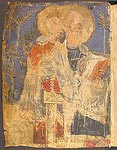Milyata Gospel. Complete Aprakos.
Late 12th cent. (?). Novgorod Lands. One of scribes: Priest Domka
F (300 ı 235). I+160 leaves.
Parchment. Ink, cinnabar, colours, gold.
It is written in a uncial script in two columns by two hands.
The illumination of the manuscript includes the miniature of St John the Evangelist and Sophia-Wisdom (?) (fol. 1v, sewed in the codex). There are initials in the Old Byzantine style in cinnabar and ink. Folio 160 contains a note of Priest Domka about the creation of two books - the Gospel and the Acts of the Apostles - by order of Milyata Lukinich during a year, which was "lean".
The Milyata Gospel is one of the earliest parchment Old Russian books. According to evidence of lean years in the 12th-13th centuries from chronicles of Novgorod Lands, the manuscript may date from: 1188, 1215 or 1230. Lately, a majority of researchers have regarded the year of 1188 as the most probable date. Since the time of the philologist Alexander Vostokov, Milyata, who commissioned the manuscript, is supposed to have a relationship to those Lukiniches, who founded the church of Sts Peter and Pavel in Novgorod Lands on 6 May in 1186 and are mentioned in the Chronicle I of Novgorod. The hypothesis of Valentin Yanin, a leading Russian historian, is that "Lukinich" is not a name, but "the indication of inhabitants of the Lukina street, the nearest to the Sinilishche (the Tomtit's Hill)".
The miniature from the manuscript is also interpreted in different ways in reseach literature. Due to some researchers, its creation is supposed to connect with such great masterpieces of Novgorod monumental painting of the 12th century, as frescos from the Saviour church at Nereditsa (Alexej Svirin). From the point of view of others, the miniature was produced in Novgorod, but "very primitively, by matching colourful surfaces: dark blue, green-grey, red, yellow with broad pattern (as an imitation of gold)" (Alexej Nekrasov). The third consider it to be a memorial, tracing back to Eastern Christian art of Asia Minor (Victor Lazarev, Gerold Vzdornov).
Text analysis of the Milyata Gospel gave evidence of that it is one of the earliest Aprakos-Gospels (Lidiya Zhukovskaya). At the beginning of the 19th century, the Milyata Gospel belonged to Ignatiy Ferapontov, a noted Moscow antiquary and sellerof manuscript and early printed books. Then the Gospel was transferred to the other collector - Pyotr Frolov, a mining engineer and inventor.
In 1812 the manuscript was acquired by the Imperial Public Library from Pyotr Frolov.
Shelfmark: –Õ¡. F.n.1.7.





